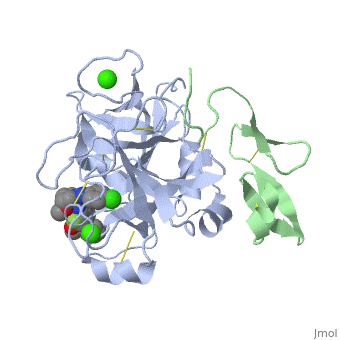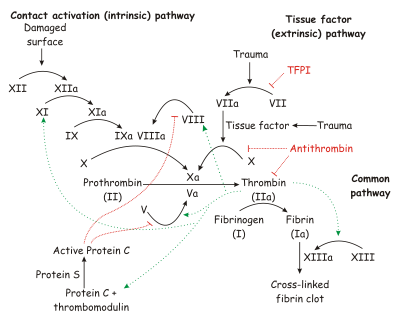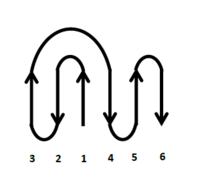Introduction
Factor X is a vitamin K-dependent glycoprotein that is synthesized in the liver. Zymogen factor X circulates in plasma as a 2 chain molecule composed of a disulfide linked light chain (Mr = 16500) and heavy chain (Mr = 42,000). Factor X is activated to factor Xa by cleavage of the activation peptide. This reaction is catalyzed by factor VIIa-tissue factor (extrinsic Xase complex) and factor IXa-factor VIIIa (intrinsic Xase complex).[1]
Factor Xa, along with factor Va, calcium, and a phospholipid membrane surface to form the prothrombinase complex, and cleave prothrombin to its active form, thrombin.[1]
Relevance
Factor Xa is inhibited by Apixaban and Rivaroxaban which are anticoagulant medications. See also Anticoagulants.
Structure
Factor Xa is a member of the chymotrypsin-like clan within the serine protease family. Other clans within the mammalian family are the subtilisin-like and α/β-hydrolase fold serine proteases. is seen in the mammalian serine protease family, and is particularly conserved in the active site geometry of the catalytic triad. The mammalian serine protease family is an example of divergent evolution from a common ancestor. [2].
Bacterial subtilisin serine protease shows no sequence or structural homology to the mammalian serine protease family, but is functionally identical. Subtilisin uses a His, Asp, Ser catalytic triad with the same mechanism of catalysis. This is an example of convergent evolution.[2]
Light Chain
The factor Xa light chain contains a γ-carboxyglutamic acid (Gla) domain γ-carboxyglutamic acid (Gla)(11 gla residues) as well as two epidermial growth factor (EGF)-like domains epidermal growth factor (EGF).[3] The vitamin K-dependent GLA-domain is a post-translational modifications of many glutamate residues by vitamin K-dependent carboxylation to form gamma-carboxyglutamate. [4] [5] This domain begins at the N-terminus of the protein and ends with a conserved aromatic residue. There is also a conserved Gla-X(3)-Gla-X-Cys motif [6], located in the middle of the GLA domain, and appears to be important for recognition by the vitamin K-dependent carboxylase. The Gla residues are responsible for the high-affinity binding of calcium ions. Based on 3D structures of several Gla domains it that the binding of calcium ions induce conformational changes in the domain and are necessary for proper folding of this region. [7]A common structural feature of Gla domains is the clustering of N-terminal hydrophobic residues into a hydrophobic patch that mediates interaction with the cell surface membrane. [8] The Gla domain enables factor X/Xa to bind phospholipid (i.e. cell surfaces) in a calcium dependent manner; a requirement for assembly of the prothrombinase complex. Factor Xa from which the Gla domain has been removed by limited chymotryptic digestion does not bind to phospholipid-factor Va and is virtually inactive. [9]. Additional detgails in Calcium ions the Gla domain.
EGF-like domains have a length of approximately 40 amino acids and are characterized by a conserved arrangement of six cysteine residues that form 3 evenly spaced disulfide bonds.[10] Factor X contains two of them located between the membrane-proximal γ-carboxyglutamic acid (Gla)- containing domain and the serine protease domain. The first EGF-like domain in these proteins contains 1 Ca2+ binding site. [11] The side chains of two Asp, one of which may be β-hydroxylated, and one Gln residue and two backbone carbonyl oxygens have been identified as Ca2+ ligands in the first EGF-like domain. [12] The affinity of this site in factor X is represented by a dissociation constant (Kd) of about 0.1 mM in the intact protein. [13] In contrast, Ca2+ binding to the isolated EGF-like domain has a 20-fold higher Kd [14]. The biological function of EGF-like domains are largely unknown, some proteins containing them, may have some EGF-like functions also. Recent crystal structures suggest that the N-terminal epidermal growth factor (EGF)-like domain is flexibly, while the second EGF domain maintains contacts with the catalytic domain.
Heavy Chain
The factor Xa heavy chain contains the activation peptide (no crystal structures of inactive Factor X containing the activation peptide have been solved) and the trypsin-like serine protease domain.
The members of the trypsin-like serine protease family have two homologous greek key β-barrel subdomains (, ) in the heavy chain. The greek key barrel is characterized as an up and down β-barrel with an n+3 linkage across the barrel, in this case, the across barrel linkage is an α-helix. The pack together asymmetrically to constitute the compact (see below for more information). Although the hydrophobic core structures remain conserved throughout the family (12), considerable variation is seen in the surface loops, especially surrounding the active site where they determine substrate specificities. [15]
Catalytic Triad
Serine proteases use a His57, Asp102, Ser195 catalytic triad, each playing an important role. The serine donates an OH group to act as a nucleophile and attack the carbonyl group of the peptide bond that will be broken within the substrate. Histidine coordinates the attack of the peptide bond by accepting the hydrogen from the serine –OH group with a pair of electrons on nitrogen. Aspartate contains a carboxyl group that aids in proper positioning of the histidine and stabilization, through hydrogen bonding.
Substrate Recognition Sites
The natural substrate of factor Xa is prothromin, which is cleaved after the arginine in the sequence: Ile12-Asp13-Gly14-Arg15-Ile16- Val17-Glu18-Gly19. Arg 15 binds in the S1 pocket, Gly 14 binds the S2 pocket, Ile 12 binds the S4 pocket. The , is located next to the catalytic triad, and is formed by loops in residues 214-220 and 189-195 that are linked by a disulfide bond . Residues 225-228 form the lower portion of the pocket.[16] The S1 pocket binding selectivity is determined by residues Asp 189, Gly 216, and Gly 226. Asp 189 (R-group pKa: 12.48) most likely forms electrostatic interactions with the S1' Arg 15 (R-group pKa: 4). The is formed by the backbone amides of Gly193 and Ser195.[17] The oxyanion hole uses its main chain amide groups to stabilize the tetrahedral intermediate.[18]
The of factor Xa is formed by the 90s loop which is positioned adjacent to His 57. Consistent with Gly 14 as the P2 element in prothrombin, S2 is a small, shallow pocket.[19]
The S3 site of factor Xa has little specificity; the side chain of the Asp 13 P3 residue protrudes out of the active site cleft.
is formed between the 90s and 170s loops and binds an Ile 12. This region contains 3 ligand binding domains. The is located at the entrance to S4 and contains Phe174, Tyr99 and Trp215, which form a deep aryl-binding pocket. The is formed by the backbone carbonyl and side chain of Glu97 and the backbone carbonyl of Lys96. The is composed of the hydrophillic side chains of Thr98, Ile175 and Thr177 and traps a water molecule. [19]
The cation-pi interaction is a strong, non-covalent bond formed by electrostatic interactions between the side chains of aromatic residues and various cations. These bonds are characterized by the fact that sp2 carbons are more electronegative then hydrogen, and 6 local Cδ- - Hδ+ bond dipoles are created around the benzene ring. Collectively, these dipoles create an accumulation of negative charge in the center of the ring and a belt of positive charge around the edge. This charge distribution allows for cation binding to the center of the ring, however, if the ring is not properly positioned, the cation will be repulsed by the positive charge of the outer ring. The S4 binding pocket of Factor Xa is formed from three aromatic residues, tyrosine 99, phenylalanine 174, tryptophan 215, sufficiently rich in properly positioned pi-electrons that it is not only a hydrophobic pocket, but also forms a cation recognition site. Many factor Xa inhibitors have a basic residue binding in this pocket, when protonated, cation-pi interactions are formed.
Hydrogen bonds form between the carbonyl oxygen of Ser214 and the NH of the P1 (Arg 14) residue, the NH of Trp215 and the carbonyl of P3 (Asp 113) and the carbonyl of Gly216 and the NH of P3 (Asp 113). These interactions are a general feature of chymotrypsin-like proteases and are critical for efficient substrate hydrolysis.
The precise interactions of the P' side chains have not been defined. The P1' and P3' residues point in the same direction as a consequence of the beta sheet alignment of the substrate, so that the S1' and S3' sites overlap. The S1'/S3' sites are bounded by His57, the 60’s loop and the 40’s loop. The P2' residue points in the opposite direction and may interact with the 150’s loop.
Helix capping
Helices have exposed hydrogen bond donors from the first 4 residues at the N-terminus. Helix capping refers to H-bonding to these groups, primarily by nearby side chains, to "seal" the helix. Factor Xa forms a helix from residue 165-171 that is by an aspartate residue number 164. The aspartate side chain is twisted to follow the helix and provide capping. The backbone carbonyl is hydrogen bonded to the backbone nitrogen groups of serine 167 and cysteine 168. One of the side chain oxygen groups of aspartate forms hydrogen bonds with the backbone nitrogen groups of asparagine 166 and serine 167. Arginine 165 is the first residue in the helix and it provides capping hydrogen bonds for lysine 169. The backbone nitrogen group of arginine 165 appears to form a hydrogen bond with the solvent. The aspartate and asparagine residues 164 and 165 provide capping hydrogen bonds for the hydrogen bond donors of the first 4 N-terminal helix residues.
Activation peptide
Chymotrypsin-like proteases are synthesized as inactive precursors, zymogens, containing N-terminal extensions. Four segments are deformed in the zymogens of chymotrypsin and trypsin: the N-terminus to residue 19, residues 142-152, 184-193, and 216- 223 (these regions are collectively termed the activation domain). This region covers the S1 site and oxyanion hole, which explains the low activity of the zymogen. Proteolytic processing activates the zymogen, releasing the N-terminal Ile16. The new N-terminus forms a buried salt bridge with Asp194, inducing a conformational change that orders the activation domain. The S1 site and oxyanion hole are formed, creating the active protease.
Post-Translational Modifications
Factor X is cleaved by factor IXa (in the intrinsic pathway), or by factor VIIa (in the extrinsic pathway) to release the activation peptide, and yield the active factor Xa. The vitamin K-dependent, enzymatic carboxylation of some glutamate residues allows the modified protein to bind calcium via the GLA domain. Zymogen human factor X has four carbohydrate-attachment sites in the activation peptide, O-glycosidic linkages are to Thr17 and Thr29, and N-glycosidic linkages are to Asn39 and Asn49.
Enzyme Mechanism
General Serine Protease Mechanism
During the acylation half of the reaction His57 acts as a general base to remove a proton from Ser195, allowing it to attack the carbonyl of the peptide bond to be broken within the substrate, to yield the first tetrahedral intermediate. The negative oxygen ion of the tetrahedral intermediate is stabilized through hydrogen bonding with the oxyanion hole (Gly192 and Ser195). Asp102 stabilizes the protonated His57 through hydrogen bonding. His57 protonates the amine of the scissile bond, promoting formation of the acylenzyme and release of the N-terminal portion of the substrate.
The deacylation portion repeats the same sequence. A water molecule is deprotonated by His57 and attacks the acyl enzyme, to yielding a second tetrahedral intermediate. Again, the tetrahedral intermediate is stabilized by the oxyanion hole. Upon collapse of the tetrahedral intermediate, the C-terminal portion of the protein is released.[18]
Controversial Mechanisms
His Flip Mechanisms

His flip mechanism proposed by Bachovchin in 2001.
[21] As stated previously, His57 removes a proton from Ser195 and transfers it to the leaving group. It can be argued that the protonated His57 could reprotonate Ser195 and regenerate the substrate. One hypothesis is that protonated His57 flips such that N1 proton could easily protonate the leaving group.
[22] This flipped conformation has been observed in another group of serine proteases, subtilisin, in a 50% dimethylformamide solution.
[21]
However, there are several arguments against the His flip mechanism. Flipping of His57 would require breaking and reforming many hydrogen bonds while the short lived tetrahedral intermediate is present. Also, His57 is sterically hindered by the P2 and P1’ residues of the peptide substrates. [23]These observations disfavor the His flip mechanism.
Low Barrier Hydrogen Bonds
. The mechanism by which the transition state is stabilized has been the topic of recent debate. Some groups suggest that His57 and Asp102 form and especially strong hydrogen bond, called a low barrier hydrogen bond (LBHB). They hypothesize that this hydrogen bond could promote formation of the transition state by stabilizing the Asp –His association and enhancing the bascisity of His57. [24] [25] This would enhance catalysis in the first step of the reaction. Formation of a LBHB requires a ΔpKa of approximately zero and a donor-to-acceptor distance of less then 2.65 Å for a nitrogen-oxygen pair like His57 and Asp102. Unlike a standard hydrogen bond, in which the hydrogen is located on the donor atom, a hydrogen in a LBHB is located equidistant between the 2 atoms. [26] In 1998 Kuhn and colleagues published a crystal structure of Bacillus lentus subtilisn, another serine proetase, with 0.78 Å resolution at pH 5.9. The structure showed a distance of approximately 2.62 Å between the His57 nitrogen and the Asp102 oxygen, suggesting a LBHB. [27]
A more recent crystal structure of α-Lytic protease, published in 2006 with 0.82 Å resolution argues against both the his flip mechanism and the presence of a LBHB between His57 and Asp102 (2.755 Å in this structure). Fuhrmann et al suggests that a LBHB may have been present in the subtilisin strucutre, it is not required for the serine protease mechanism. Instead they state that the chymotrypsin-like proteases may use a network of optimized hydrogen bonds to position the stabilize the tetrahedral intermediate and position the catalytic triad. Ser195 undergoes a shift of ~1Å upon protonation of His57 that destabilizes the His57-Ser195 H-bond. This conformation change would prevent His57 from reprotonating Ser195 leading to regeneration of the substrate.[26]





